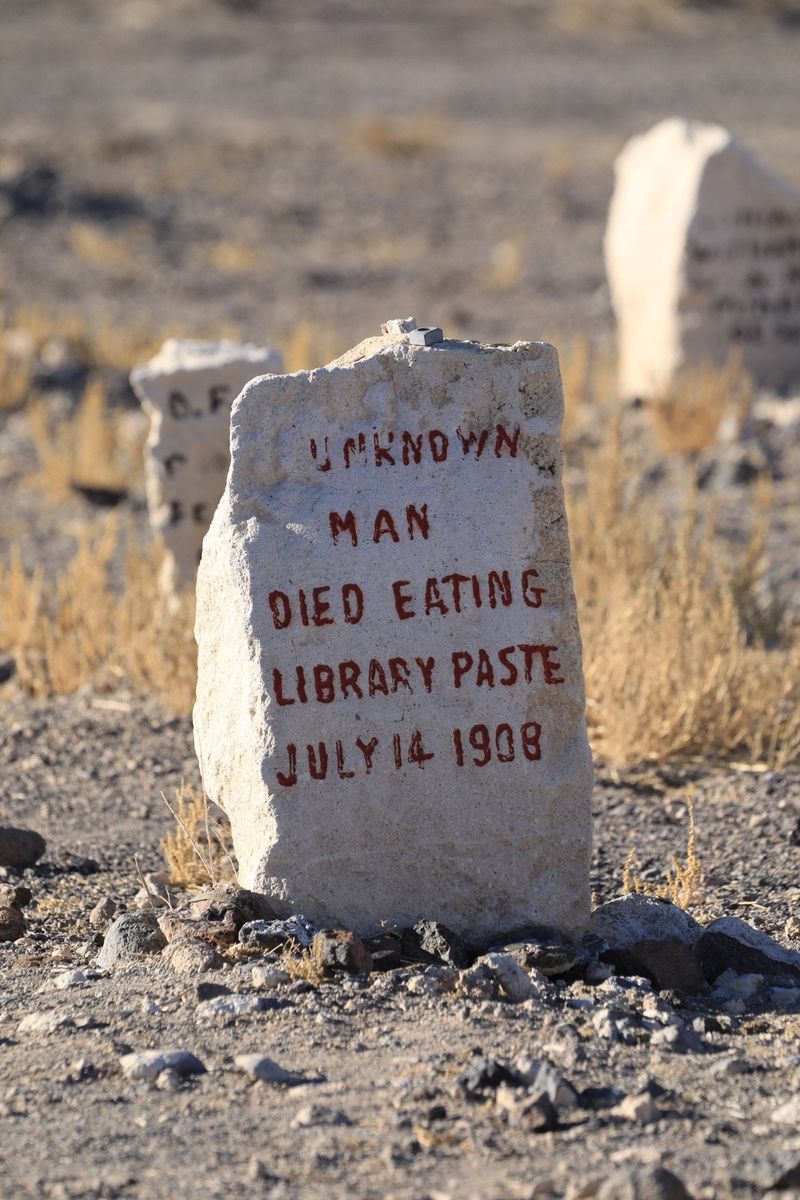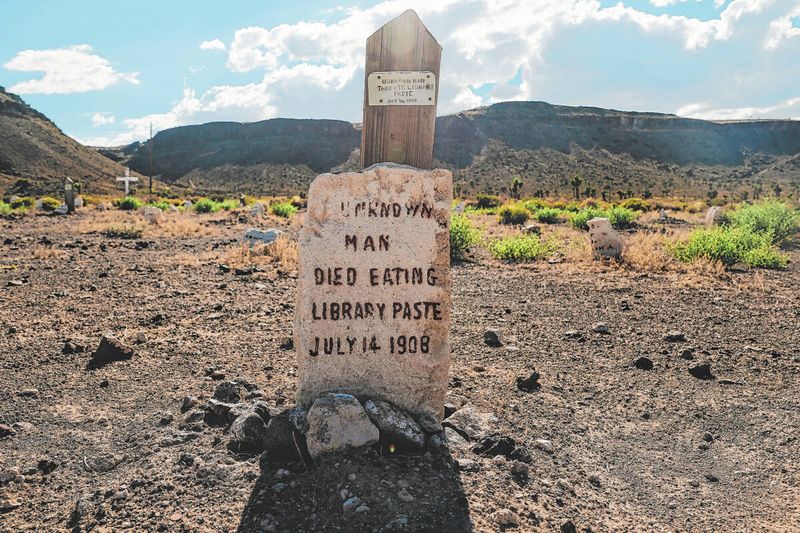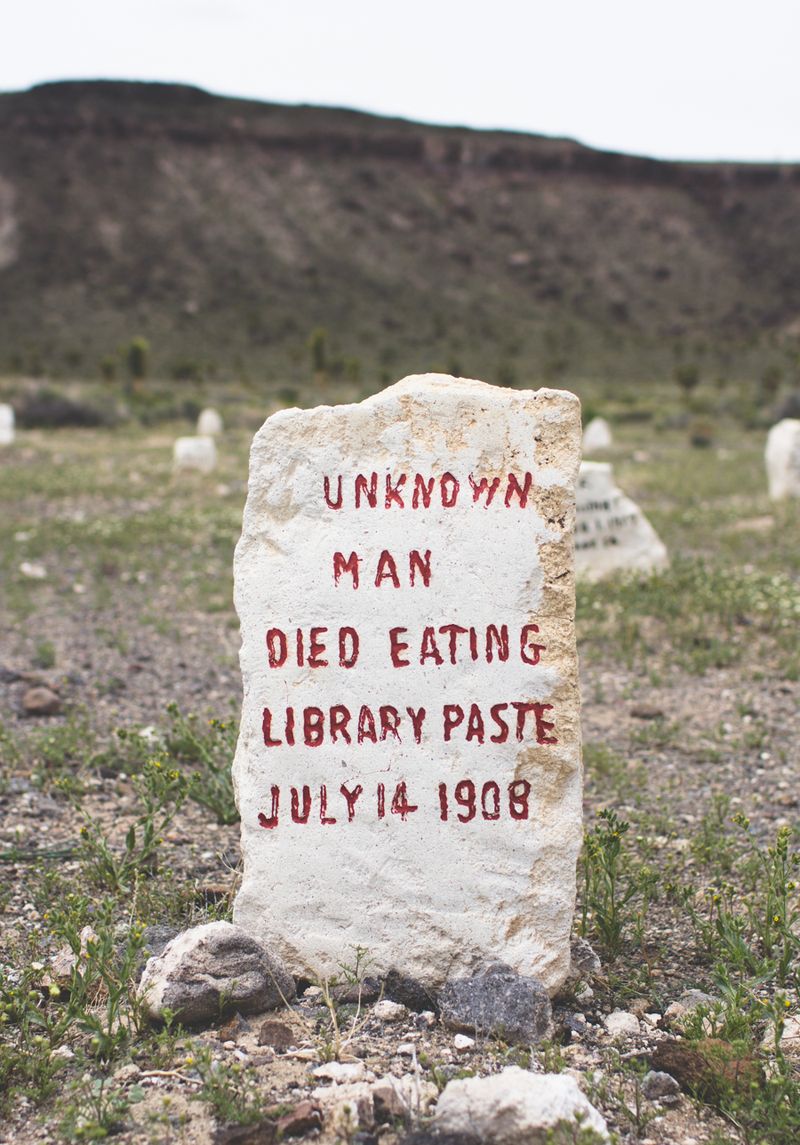Deep in the Nevada desert sits one of America’s strangest gravestones. The marker tells a story so unusual that visitors often wonder if it’s real or just an elaborate joke. In Goldfield’s Pioneer Cemetery, a modest headstone commemorates an unknown vagrant who died in 1908 after eating library paste he found in the trash. This odd memorial has become a quirky piece of local history that raises questions about poverty, desperation, and how we remember the forgotten.
The Strange Epitaph & Location
Goldfield Pioneer Cemetery holds a gravestone unlike any other in America. The inscription reads simply: “UNKNOWN MAN DIED EATING LIBRARY PASTE JANUARY 14 1908.” No name, no age, just this bizarre cause of death carved into stone.
Local legend tells of a homeless man scavenging through trash bins outside the town library. He discovered a jar of book-paste used for binding and repairs, mistook it for food, and consumed it without knowing the mixture contained about 60% alum—a toxic chemical compound. The poisoning proved fatal.
Finding this grave requires some effort and curiosity. It sits tucked away in the cemetery’s far southwestern corner, behind a section called “Elk’s Rest,” hidden from the main entrance. Visitors must follow a dusty vehicle path to reach it, making the discovery feel like uncovering a secret piece of forgotten history.
A Legacy of Humor, Memory & Caution
What makes this grave fascinating is how it operates on multiple levels at once. On the surface, it’s a bizarre historical footnote that makes people do a double-take. Some view it as a cautionary tale warning against eating mysterious substances found in garbage bins.
Others suspect the whole thing might be folk humor or even a prank that’s been maintained over decades. The gravestone’s bright red paint has sparked debate—did someone recently refresh it to keep the joke alive? The vivid coloring seems suspiciously well-preserved for something over a century old.
Whether the incident happened exactly as described or has been embellished through generations of retelling, the grave has achieved legendary status. It’s become a popular photo opportunity for travelers exploring Nevada’s quirky roadside attractions, blending tragedy with dark comedy in a way that keeps people talking and visiting year after year.
Context & Meaning in Goldfield’s Mining Town
During the early 1900s, Goldfield thrived as a booming gold-mining town attracting fortune-seekers from across the country. Amid stories of wealth and industrial progress, darker realities existed alongside the glamour. The Paste Eater’s Grave represents those untold stories of poverty and desperation that history books often overlook.
The fact that this person remains identified only as “unknown man” speaks volumes about invisible lives lived on society’s margins. While mine owners and successful prospectors received proper burials with elaborate headstones, this vagrant received only a basic marker noting his peculiar demise.
Yet this very strangeness has given him a kind of immortality that many wealthier citizens never achieved. The bizarre cause of death makes his grave stand out among traditional memorials, forcing us to acknowledge how history remembers—or chooses to remember—the unusual and uncomfortable alongside the celebrated.
Visiting & Reflections
Traveling to Goldfield and seeking out the Paste Eater’s Grave offers more than just a quirky photo opportunity. The cemetery is free and accessible, though the grave’s hidden location turns finding it into a small adventure. That search becomes part of the experience, building anticipation.
Standing before this unusual marker invites deeper questions. What circumstances led to such desperation? Was the man suffering from hunger, mental distress, or simple misfortune? Did anyone mourn him, or was he completely alone in the world?
The gravestone provides no answers to these questions, and perhaps that’s fitting. The silence surrounding his identity and circumstances creates space for personal reflection on poverty, isolation, and human vulnerability. History contains countless small stories like this one—lives that touched the world briefly before vanishing, sometimes memorialized in the most unexpected and poignant ways.








